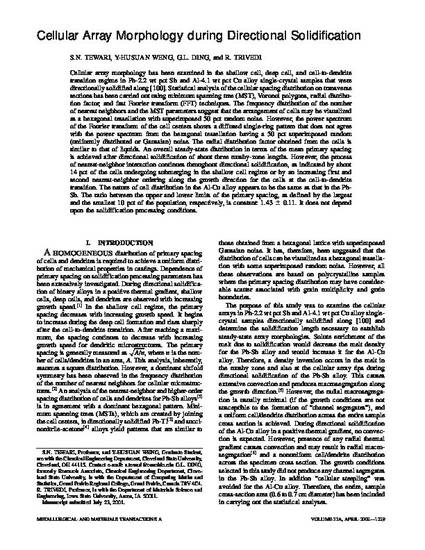
Cellular array morphology has been examined in the shallow cell, deep cell, and cell-to-dendrite transition regime in Pb-2.2 wt pct Sb and Al-4.1 wt pct Cu alloy single-crystal samples that were directionally solidified along [100]. Statistical analysis of the cellular spacing distribution on transverse sections has been carried out using minimum spanning tree (MST), Voronoi polygons, radial distribution factor, and fast Fourier transform (FFT) techniques. The frequency distribution of the number of nearest neighbors and the MST parameters suggest that the arrangement of cells may be visualized as a hexagonal tessellation with superimposed 50 pct random noise. However, the power spectrum of the Fourier transform of the cell centers shows a diffused single-ring pattern that does not agree with the power spectrum from the hexagonal tessellation having a 50 pct superimposed random (uniformly distributed or Gaussian) noise. The radial distribution factor obtained from the cells is similar to that of liquids. An overall steady-state distribution in terms of the mean primary spacing is achieved after directional solidification of about three mushy-zone lengths. However, the process of nearest-neighbor interaction continues throughout directional solidification, as indicated by about 14 pct of the cells undergoing submerging in the shallow cell regime or by an increasing first and second nearest-neighbor ordering along the growth direction for the cells at the cell-to-dendrite transition. The nature of cell distribution in the Al-Cu alloy appears to be the same as that in the Pb-Sb. The ratio between the upper and lower limits of the primary spacing, as defined by the largest and the smallest 10 pct of the population, respectively, is constant: 1.43 +/- 0.11. It does not depend upon the solidification processing conditions.
Available on publisher's site at: http://www.asminternational.org/portal/site/www/AsmStore/ProductDetails/?vgnextoid=a6a3c777b3426210VgnVCM100000621e010aRCRD.
